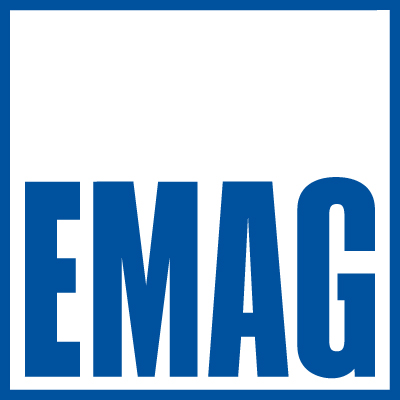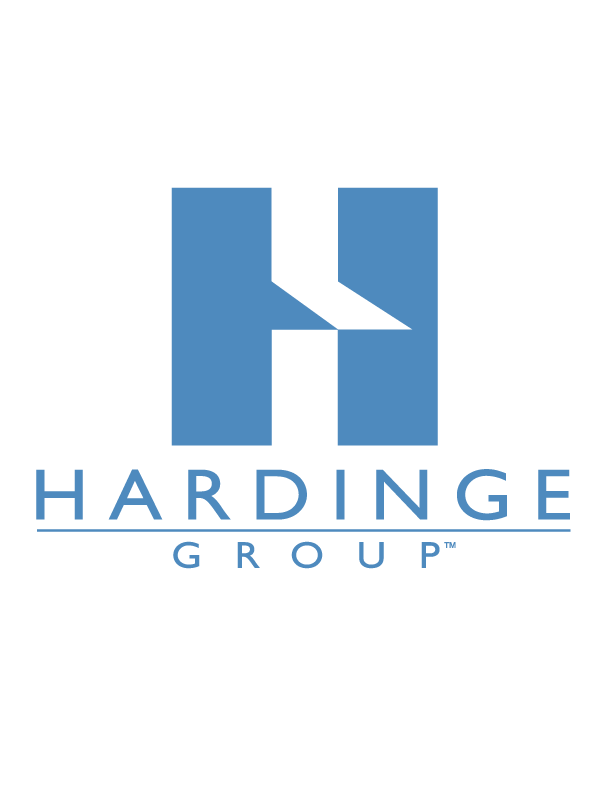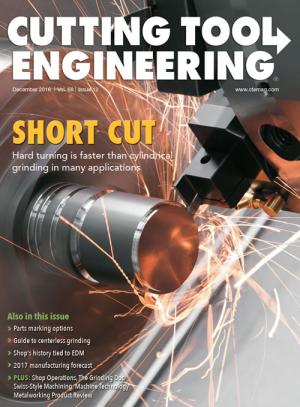Hard turning is used to finish a variety of parts, such as bearing journals and races, brake drums and rotors, cylinder bore liners, gears, pinions and splines—or to semifinish those same components prior to grinding. Properly applied, it achieves an accuracy best measured in microns and, in many cases, is faster and more cost-effective than cylindrical grinding.
Opinions vary on the definition of hard turning. Some industry experts say it’s the single-edge cutting of hardened steels from 58 to 68 HRC, while others suggest hard turning begins at 45 HRC and includes hardened irons and superalloys. All, however, agree it presents difficulties but is quite manageable provided the right cutting tools, machine and process parameters are used.

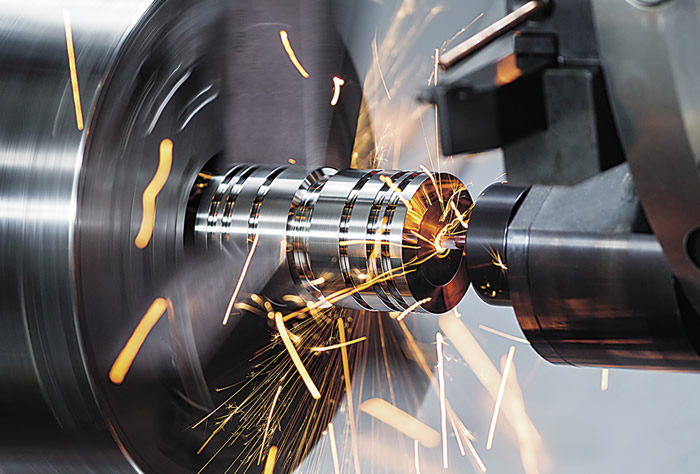
Horn added to its Supermini line for boring workpieces as hard as 66 HRC without the use of PCBN. Image courtesy Horn USA Inc., Nico Sauermann.

Making Choices
Let’s start with cutting tools. Don Graham, manager of education and technical services for Seco Tools LLC, Troy, Mich., said that if the setup is fairly rigid and the correct cutting parameters can be achieved, indexable PCBN inserts are generally the best bet for hard turning.
“A cutting speed of 600 sfm is a good starting point for PCBN,” he said. “We recommend a double-sided round insert where possible, carefully rotating it as the tool wears. Depending on depth of cut, this might provide 10 to 20 uses per side. Some shops are scared off by the relatively high price of these inserts, however. In these cases, we’d likely suggest a PCBN-tipped insert —or even one of our new superhard carbide grades.”
Graham said the company’s TH carbide can successfully turn materials up to 65 HRC and, unlike PCBN, is available in a range of geometries and chipbreaker configurations. And carbide is less prone to breakage in some applications—a casehardened shaft, for example, where it’s possible that softer material might be encountered, which would quickly dissolve the cutting edge and spell near-certain doom for the PCBN insert.

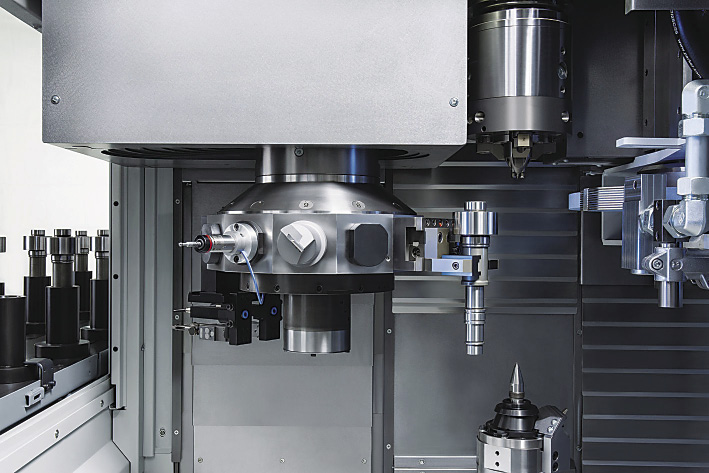
This vertical lathe combines turning and grinding in a single machine. Image courtesy EMAG.

Initially, carbide is also less expensive, although Graham pointed out that cost per edge favors PCBN. “PCBN might cost 10 to 25 times more than carbide, but you’re also going to get 50 to 100 times the tool life. Certainly, for high production, PCBN is the way to go.”
Indexable ceramics are another option. Jack Kohler, applications engineer for Greenleaf Corp., Saegertown, Pa., said the cost of ceramic cutting tools falls somewhere between PCBN and carbide, and offers equivalent or better performance in some applications. “Ceramic does quite well in the 50-HRC to 65-HRC range,” he said. “Cutting speeds would be comparable to PCBN. Figure around 700 sfm on a 55-HRC A-2 tool steel, for example, with only slightly lower tool life.”
Kohler said he’s seeing increased use of ceramic in high-temperature alloys, such as Inconel 718 and Hastelloy, although he warns shops to steer clear of titanium, as this presents a fire risk because titanium chips can burst into flames at the high cutting speeds common with ceramics. Regardless of the metal being cut, ceramic inserts usually come with a slight hone, land or combination of the two at the cutting edge to prevent chipping and increase strength.
Ceramics should be run dry in hardened materials, Kohler said. He recommends Greenleaf’s WG-600 silicon-nitride grade—a CVD-coated version of the company’s whisker-reinforced WG-300—as a good starting point for most hardened steels, as well as its new XSYTIN-1, a phase-toughened ceramic grade designed specifically for high-performance roughing and interrupted cuts.
In or Out?
Some might wonder about the difference between hard turning the inside of a part (boring) and its outside. Most agree that boring is generally more difficult than OD turning, regardless of material hardness. That’s because boring bars are less rigid than other turning tools, creating problems with chatter and tool deflection. Because quarters are often tight in a bored hole, chip evacuation can be a challenge, leading to coolant starvation and workpiece galling. In addition, achieving sufficient surface speeds becomes increasingly difficult for small part features, such as bores, and PCBN and ceramic inserts require high cutting speeds.
The solution, experts agree, is to apply the shortest tool possible relative to tool diameter, preferably no greater than a 4:1 length-to-diameter (L:D) ratio. Boring bars should be on center or, in some cases, a few tenths (0.0003") above center to allow for deflection. And use a boring insert with a 0° lead angle whenever possible, so cutting forces are directed opposite the direction of cut.
“An often-overlooked component of ID work is accounting for the axial, radial and tangential cutting forces produced when turning,” said Mike Csizmar, regional sales manager at Horn USA Inc., Franklin, Tenn. “This is also true on external operations, but due to the increased L:D ratios associated with boring, these forces become more pronounced, affecting dimensional qualities. If you have a choice, axial (Z-axis) cutting force is preferred. A rule of thumb is that DOC should be equal to or greater than the tool nose radius, thus generating greater axial force. This provides the ability to control chatter, diameter and taper in a more efficient manner, and allows you to get the most out of your cutting tool.”
Enhanced Precision
Tom Sheehy, applications engineering manager for Hardinge Inc., Elmira N.Y., said hard turning can be performed on virtually any lathe and provides many benefits.
“Hard turning offers lower machine investment, reduced setup and tool inventory, fewer operations, faster cycle times and greater process flexibility,” he said. “Unfortunately, many shops can use it only for semifinishing of parts prior to grinding, primarily because the majority of CNC lathes are unable to achieve the extreme tolerances and form accuracy produced by cylindrical grinding machines.”

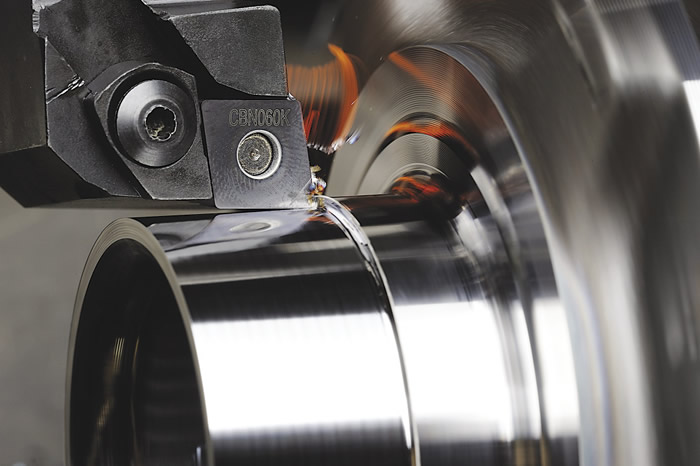
Turning a part with a Seco PCBN-tipped insert. Image courtesy Seco Tools.

CNC grinders are routinely called upon to produce part roundness of 1μm (0.00004"), maintain diametral tolerances of ±2.5μm (0.0001") and impart surface finishes as fine as 8 rms or finer. Sheehy said the only way a CNC lathe can compete in this arena is if it is designed from the ground up for hard turning.
“Hardinge Super-Precision lathes offer 0.1μm programmable resolution,” he said. “Axial errors are mapped and compensated for electronically. All mating surfaces within the machine are hand-scraped, the linear guide ways and ballscrews are oversized, and the base of the machine is filled with composite polymer for vibration damping. Not only does this produce the accuracy and rigidity needed to replace many grinding operations, it also increases tool life during hard turning by up to 30 percent.”
Despite these capabilities, some parts are not suitable for hard turning. Bearing seals, for example, often call for ground surfaces, which eliminate the possibility of fluid escaping through what is essentially a microscopic thread-wide channel produced by single-point turning. And the “white zone” created when material softens and subsequently rehardens during turning (and grinding to a lesser extent) may cause premature component failure. Sheehy said both of these situations can be minimized with the right tooling and a few process adjustments.
Combining Technologies
Some machine builders, Hardinge included, offer turning and grinding machines, making them trusted advisers on which process is most suitable for a given part. Another is EMAG LLC USA, Farmington Hills, Mich., which also offers machines that grind and hard-turn. The company’s director of sales, Kirk Stewart, agreed that hard turning offers many opportunities for improvement in productivity and part quality, and proper machine design is critical to success.

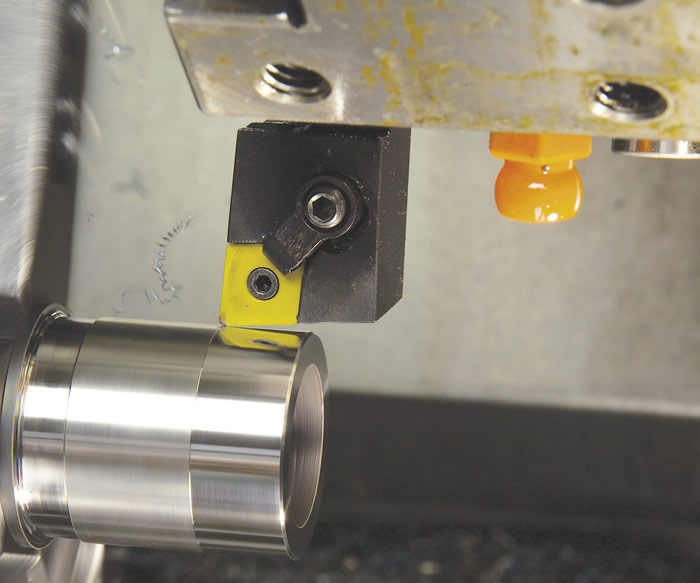
Turning with ceramic inserts is usually done dry. Here the toolholder is mounted face up, driving cutting forces down into the machine’s load-bearing surfaces. Image courtesy Greenleaf.

“A significant benefit of changing from grinding to hard turning is the reduction in capital investment,” Stewart said. “Grinding, however, does have its place and is, in some instances, a faster process when multiple features are ground simultaneously—a situation that is ideal for high-volume applications. Thus, in a high-volume environment, when there are only one or two features that require finishing, hard turning might be the better process for overall capital investment.
“Alternatively, when the machine architecture allows, a combined configuration of turning and grinding can become very attractive for mid-volume requirements, an architecture that EMAG machines inherently provide.”

Contributors
EMAG LLC USA
(248) 477-7440
www.emag.com
Greenleaf Corp.
(800) 458-1850
www.greenleafcorporation.com
Hardinge Inc.
(800) 843-8801
www.hardinge.com
Horn USA Inc.
(888) 818-HORN
www.hornusa.com
Seco Tools LLC
(248) 528-5200
www.secotools.com/us
Contact Details
Contact Details
Contact Details
Contact Details
Contact Details
Related Glossary Terms
- alloys
alloys
Substances having metallic properties and being composed of two or more chemical elements of which at least one is a metal.
- axial force
axial force
When drilling, a force that is directed axially—along the direction of machining. The magnitude of an axial force rises with the drill’s diameter and the chisel edge’s width. Axial force is also known as thrust. When turning and boring, the term “feed force” is commonly used instead of “axial force.” See cutting force.
- boring
boring
Enlarging a hole that already has been drilled or cored. Generally, it is an operation of truing the previously drilled hole with a single-point, lathe-type tool. Boring is essentially internal turning, in that usually a single-point cutting tool forms the internal shape. Some tools are available with two cutting edges to balance cutting forces.
- ceramics
ceramics
Cutting tool materials based on aluminum oxide and silicon nitride. Ceramic tools can withstand higher cutting speeds than cemented carbide tools when machining hardened steels, cast irons and high-temperature alloys.
- chatter
chatter
Condition of vibration involving the machine, workpiece and cutting tool. Once this condition arises, it is often self-sustaining until the problem is corrected. Chatter can be identified when lines or grooves appear at regular intervals in the workpiece. These lines or grooves are caused by the teeth of the cutter as they vibrate in and out of the workpiece and their spacing depends on the frequency of vibration.
- chipbreaker
chipbreaker
Groove or other tool geometry that breaks chips into small fragments as they come off the workpiece. Designed to prevent chips from becoming so long that they are difficult to control, catch in turning parts and cause safety problems.
- computer numerical control ( CNC)
computer numerical control ( CNC)
Microprocessor-based controller dedicated to a machine tool that permits the creation or modification of parts. Programmed numerical control activates the machine’s servos and spindle drives and controls the various machining operations. See DNC, direct numerical control; NC, numerical control.
- coolant
coolant
Fluid that reduces temperature buildup at the tool/workpiece interface during machining. Normally takes the form of a liquid such as soluble or chemical mixtures (semisynthetic, synthetic) but can be pressurized air or other gas. Because of water’s ability to absorb great quantities of heat, it is widely used as a coolant and vehicle for various cutting compounds, with the water-to-compound ratio varying with the machining task. See cutting fluid; semisynthetic cutting fluid; soluble-oil cutting fluid; synthetic cutting fluid.
- cutting force
cutting force
Engagement of a tool’s cutting edge with a workpiece generates a cutting force. Such a cutting force combines tangential, feed and radial forces, which can be measured by a dynamometer. Of the three cutting force components, tangential force is the greatest. Tangential force generates torque and accounts for more than 95 percent of the machining power. See dynamometer.
- cutting speed
cutting speed
Tangential velocity on the surface of the tool or workpiece at the cutting interface. The formula for cutting speed (sfm) is tool diameter 5 0.26 5 spindle speed (rpm). The formula for feed per tooth (fpt) is table feed (ipm)/number of flutes/spindle speed (rpm). The formula for spindle speed (rpm) is cutting speed (sfm) 5 3.82/tool diameter. The formula for table feed (ipm) is feed per tooth (ftp) 5 number of tool flutes 5 spindle speed (rpm).
- cylindrical grinding
cylindrical grinding
Grinding operation in which the workpiece is rotated around a fixed axis while the grinding wheel is fed into the outside surface in controlled relation to the axis of rotation. The workpiece is usually cylindrical, but it may be tapered or curvilinear in profile. See centerless grinding; grinding.
- depth of cut
depth of cut
Distance between the bottom of the cut and the uncut surface of the workpiece, measured in a direction at right angles to the machined surface of the workpiece.
- galling
galling
Condition whereby excessive friction between high spots results in localized welding with subsequent spalling and further roughening of the rubbing surface(s) of one or both of two mating parts.
- grinding
grinding
Machining operation in which material is removed from the workpiece by a powered abrasive wheel, stone, belt, paste, sheet, compound, slurry, etc. Takes various forms: surface grinding (creates flat and/or squared surfaces); cylindrical grinding (for external cylindrical and tapered shapes, fillets, undercuts, etc.); centerless grinding; chamfering; thread and form grinding; tool and cutter grinding; offhand grinding; lapping and polishing (grinding with extremely fine grits to create ultrasmooth surfaces); honing; and disc grinding.
- hard turning
hard turning
Single-point cutting of a workpiece that has a hardness value higher than 45 HRC.
- hardness
hardness
Hardness is a measure of the resistance of a material to surface indentation or abrasion. There is no absolute scale for hardness. In order to express hardness quantitatively, each type of test has its own scale, which defines hardness. Indentation hardness obtained through static methods is measured by Brinell, Rockwell, Vickers and Knoop tests. Hardness without indentation is measured by a dynamic method, known as the Scleroscope test.
- inner diameter ( ID)
inner diameter ( ID)
Dimension that defines the inside diameter of a cavity or hole. See OD, outer diameter.
- land
land
Part of the tool body that remains after the flutes are cut.
- lathe
lathe
Turning machine capable of sawing, milling, grinding, gear-cutting, drilling, reaming, boring, threading, facing, chamfering, grooving, knurling, spinning, parting, necking, taper-cutting, and cam- and eccentric-cutting, as well as step- and straight-turning. Comes in a variety of forms, ranging from manual to semiautomatic to fully automatic, with major types being engine lathes, turning and contouring lathes, turret lathes and numerical-control lathes. The engine lathe consists of a headstock and spindle, tailstock, bed, carriage (complete with apron) and cross slides. Features include gear- (speed) and feed-selector levers, toolpost, compound rest, lead screw and reversing lead screw, threading dial and rapid-traverse lever. Special lathe types include through-the-spindle, camshaft and crankshaft, brake drum and rotor, spinning and gun-barrel machines. Toolroom and bench lathes are used for precision work; the former for tool-and-die work and similar tasks, the latter for small workpieces (instruments, watches), normally without a power feed. Models are typically designated according to their “swing,” or the largest-diameter workpiece that can be rotated; bed length, or the distance between centers; and horsepower generated. See turning machine.
- lead angle
lead angle
Angle between the side-cutting edge and the projected side of the tool shank or holder, which leads the cutting tool into the workpiece.
- outer diameter ( OD)
outer diameter ( OD)
Dimension that defines the exterior diameter of a cylindrical or round part. See ID, inner diameter.
- polycrystalline cubic boron nitride ( PCBN)
polycrystalline cubic boron nitride ( PCBN)
Cutting tool material consisting of polycrystalline cubic boron nitride with a metallic or ceramic binder. PCBN is available either as a tip brazed to a carbide insert carrier or as a solid insert. Primarily used for cutting hardened ferrous alloys.
- superalloys
superalloys
Tough, difficult-to-machine alloys; includes Hastelloy, Inconel and Monel. Many are nickel-base metals.
- toolholder
toolholder
Secures a cutting tool during a machining operation. Basic types include block, cartridge, chuck, collet, fixed, modular, quick-change and rotating.
- turning
turning
Workpiece is held in a chuck, mounted on a face plate or secured between centers and rotated while a cutting tool, normally a single-point tool, is fed into it along its periphery or across its end or face. Takes the form of straight turning (cutting along the periphery of the workpiece); taper turning (creating a taper); step turning (turning different-size diameters on the same work); chamfering (beveling an edge or shoulder); facing (cutting on an end); turning threads (usually external but can be internal); roughing (high-volume metal removal); and finishing (final light cuts). Performed on lathes, turning centers, chucking machines, automatic screw machines and similar machines.

